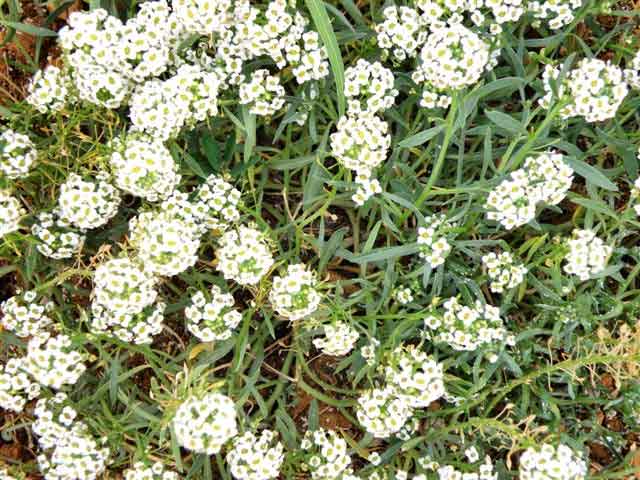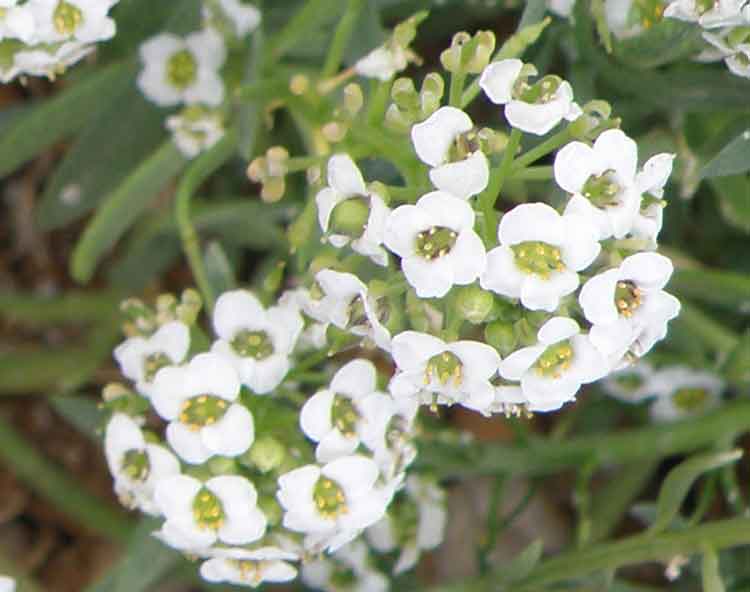
Lobularia maritima, Photo: Augusta Stylianou
Classification System: APG IV
Superregnum: Eukaryota
Regnum: Plantae
Cladus: Angiosperms
Cladus: Eudicots
Cladus: Core eudicots
Cladus: Rosids
Cladus: Eurosids II
Ordo: Brassicales
Familia: Brassicaceae
Tribus: Anastaticeae
Genus: Lobularia
Species: Lobularia maritima
Subspecies: L. m. subsp. columbretensis – L. m. subsp. maritima
Name
Lobularia maritima (L.) Desv. (1814)
Synonymy
Basionym
Clypeola maritima L.
Homotypic
Alyssum maritimum (L.) Lam.
Koniga maritima (L.) R.Br.

Lobularia maritima, Photo: Augusta Stylianou
References
J. Bot. Agric. 3: 162.
Links
Koch, M.A. et al. 2019. Lobularia maritima in BrassiBase Tools and biological resources to study characters and traits in the Brassicaceae. Published online. Accessed: 2019 May 13.
International Plant Names Index. 2019. Lobularia maritima. Published online. Accessed: May 13 2019.
Vernacular names
العربية: خرم الإبرة البحري
català: Morrisà bord
čeština: Tařicovka přímořská
Cymraeg: Alyswm pêr
dansk: Biblomme
Deutsch: Strand-Silberkraut
English: Sweet Alyssum
español: Aliso de Mar
eesti: Kivikilbik
euskara: Latxortena
فارسی: گل عسل
suomi: Tuoksupielus
français: Alysson maritime
italiano: Alisso odoroso
lietuvių: Lobuliarija
македонски: Штитница
Nederlands: Zilverschildzaad
polski: Lobularia nadmorska
português: Alisso
русский: Газонница приморская
sardu: Filigranu
svenska: Strandkrassing
Türkçe: Kraliyet halısı
中文: 香雪球
Lobularia maritima (syn. Alyssum maritimum) is a species of low-growing flowering plant in the family Brassicaceae. Its common name is sweet alyssum or sweet alison,[1] also commonly referred to as just alyssum (from the genus Alyssum in which it was formerly classified).
Etymology
The genus name Lobularia comes from a Greek word meaning 'small pod', referring to the shape of the fruits. The name of the species maritima refers to its preferred coastal habitat.[2]
Description
Lobularia maritima is an annual plant (rarely a short-lived perennial plant)[3] growing to 5–30 cm (2–12 in) tall by 20–30 cm (8–12 in) broad. The stem is very branched, with dense clusters of small flowers. The leaves are 1–4 mm long and 3–5 mm, broad, alternate, sessile, quite hairy, oval to lanceolate, with an entire margin.
The flowers are about 5 millimetres (0.20 in) in diameter, sweet-smelling, with an aroma similar to that of honey, with four white rounded petals (or pink, rose-red, violet. yellow and lilac[3]) and four sepals. The six stamens have yellow anthers. The flowers are produced throughout the growing season, or year-round in areas free of frost. They are pollinated by insects (entomophily). The fruits are numerous elongated seedpods rather hairy, oval to rounded, each containing two seeds. The dispersal of seed is affected by the wind (anemochory).
Distribution
This plant is native to the Macaronesia region: (Canary Islands, Madeira, Cape Verde) and in France in the Bay of Biscay. It is widely naturalized elsewhere in the temperate world, including the United States. There is an endemic subspecies in the local flora of the Columbretes Islands of the western Mediterranean.[4]
Habitat
It is common on sandy beaches and dunes, but can also grow on cultivated fields, walls, slopes and waste ground, preferably on calcareous soil, at an altitude of 0–300 metres (0–984 ft) above sea level.
Cultivation
Lobularia maritima is cultivated in gardens, with many horticultural varieties with purple or pink flowers. The plant is best planted in early spring, but requires little maintenance when growing. Although an annual, it may reseed in temperate climates.[3] It will flower more profusely if spent blooms are trimmed. When grown in gardens, it is typically used as groundcover, as it rarely grows higher than 20 cm (8 in) tall. It is also grown in cracks in paving and walls, and is especially associated with coastal locations. It prefers partial shade, and is resistant to heat and drought. Plants with darker-colored flowers do better in cooler temperatures. Lobularia maritima has high drought and heat resistance.
Cultivars
(Those marked agm have gained the Royal Horticultural Society’s Award of Garden Merit.)[5]
'Snow Cloth' (white)
'Royal Carpet' (purple)
'Benthamii'
'Carpet of Snow'
'Easter Bonnet Violet'
Golf Series agm[6]
'Little Dorrit'
'Navy Blue'
'New Carpet of Snow'
'Oriental Nights'
'Rosie O’Day' agm[7]
'Snow Crystals'
'Snowdrift' agm[8]
'Sweet White'
'Tiny Tim'[9]
'Violet Queen' agm[10]
'Wonderland Copper'
'Wonderland White' agm[11]
Uses
The petals, leaves, and tender stems of the plant can be eaten raw or cooked.[12]
Synonyms
Alyssum maritimum f. argentatum Font Quer
Alyssum maritimum f. crassifolium Font Quer
Alyssum maritimum f. densiflorum (Lange) Briq.
Alyssum maritimum f. densiflorum (Lange) Samp.
Alyssum maritimum f. virescens Font Quer
Alyssum maritimum var. densiflorum (Lange) Rouy & Foucaud
Alyssum maritimum var. genuinum Rouy & Foucaud
Alyssum maritimum var. lepidoides Ball
Alyssum maritimum var. macrophyllum Pau
Alyssum maritimum (L.) Lam.
Alyssum murcicum Sennen
Alyssum odoratum hort.
Alyssum strigulosum (Kuntze) Amo
Clypeola maritima L.
Koniga maritima var. densiflora (Lange) Rouy
Koniga maritima var. genuina Rouy
Koniga maritima var. strigulosa (Kuntze) Rouy
Koniga maritima (L.) R. Br. in Denham & Clapperton
Koniga strigulosa (Kuntze) Nyman
Lobularia maritima f. densiflora (Lange) Maire
Lobularia maritima subsp. columbretensis R. Fern.
Lobularia maritima (L.) Desv. subsp. maritima (L.) Desv.
Lobularia maritima var. densiflora Lange
Lobularia strigulosa (Kuntze) Willk. in Willk. & Lange
Ptilotrichum strigulosum Kunze
References
"RHS Plantfinder - Lobularia maritima". Retrieved 30 April 2018.
Coombes, Allen J. (2012). The A to Z of plant names. USA: Timber Press. pp. 312. ISBN 9781604691962.
Bruce Asakawa; Sharon Asakawa (3 September 2001). California Gardener's Guide. Cool Springs Press. p. 22. ISBN 978-1-930604-47-6. Retrieved 25 November 2011.
Paratype of Lobularia maritima (L.) Desv. subsp. columbretensis R. Fern.
"AGM Plants - Ornamental" (PDF). Royal Horticultural Society. July 2017. p. 61. Retrieved 25 March 2018.
"RHS Plant Selector - Lobularia maritima Golf Series". Retrieved 29 October 2020.
"RHS Plant Selector - Lobularia maritima 'Rosie O'Day'". Retrieved 2 October 2020.
"RHS Plant Selector - Lobularia maritima 'Snowdrift'". Retrieved 2 October 2020.
"Alyssum Sweet Tiny Tim Seeds".
"RHS Plant Selector - Lobularia maritima 'Viollet Queen'". Retrieved 2 October 2020.
"RHS Plant Selector - Lobularia maritima 'Wonderland White'". Retrieved 29 October 2020.
Nyerges, Christopher (2016). Foraging Wild Edible Plants of North America: More than 150 Delicious Recipes Using Nature's Edibles. Rowman & Littlefield. p. 15. ISBN 978-1-4930-1499-6.
Retrieved from "http://en.wikipedia.org/"
All text is available under the terms of the GNU Free Documentation License

